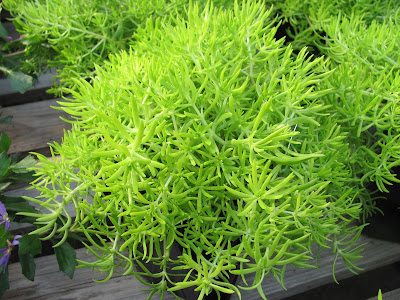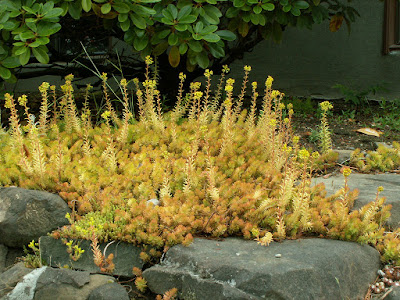Lemon Coral Sedum looks similar to Sedum Angelina, but it is a brighter color and a bit taller. It is a dense golden yellow mounding dwarf Sedum with a tight and spreading to trailing habit making it perfect for sunny borders, rock gardens, or spilling from containers.
Lemon Coral Sedum also called as Sedum mexicanum 'Lemon Coral', Petrosedum reflexum 'Lemonball', Petrosedum mexicanum 'Lemon Ball', Sedum rupestre 'Lemon Coral'™, Sedum rupestre 'Lemonball', Sedum rupestre 'Lemon Ball', Sedum mexicanum 'Lemon Ball', Sedum Lemon Ball, Lemonball Sedum, is a cultivars of Petrosedum mexicanum.
This bright lemon yellow selection looks similar to Sedum Angelina, but it is a brighter color and a bit taller. It is a dense golden yellow mounding dwarf Sedum with a tight and spreading to trailing habit making it perfect for sunny borders, rock gardens, or spilling from containers.
IDENTIFY LEMON CORAL SEDUM
Lemon Coral Sedum is a low-growing herbaceous perennial succulent which will grow to be about 8 inches tall at maturity, with a spread of 12 inches, with vibrant chartreuse, yellow, and light and bright green foliage. Its tiny leaves are slightly plump but pointy. And its foliage completely covers its branches. The color and lush presentation make it the perfect partner for flowers and other succulents.
It grows at a fast rate, and under ideal conditions can be expected to live for approximately 10 years. Sedum mexicanum 'Lemon Coral' is a real treat when it blooms, displaying flat-topped groupings of small yellow star-shaped flower clusters that bloom June through August.
LEMON CORAL SEDUM CARE AND CULTURE
Cultural information should only be used as a guide, and should be to be adapted to suit you. Your physical location; where you grow your plants, how much time you have to devote to their care, and many other factors, will need to be taken into account. Only then can you decide on the cultural methods that best suit you and your plants.
Light:
Lemon Coral Sedum will grow in full sun to part shade; however, too much shade can cause them to lose their bright yellowish foliage color. Its yellow foliage is promoted by a location in full sun. It is highly tolerant of urban pollution and will even thrive in inner city environments.
Temperature:
Sedum mexicanum 'Lemon Coral' grow well in USDA zones 7 to 11. Known for its ability to thrive in the heat, this plant will become a go-to for the sunniest, driest areas of your garden or yard, once established. In fact, this lemon looker tolerates heat better than other Sedum varieties.
Substrate and growing media:
Lemon Coral Sedum tolerates a wide range of average, well-drained, garden soils; prefers sandy to gravelly soils of moderate to low fertility and needs good soil drainage. It is used in a rock garden where it can sprawl gracefully around boulders and shrubs. It adds both color and texture to any garden bed, and contrasts nicely with dark- or burgundy-leaved plants. Note that the fleshy stems are somewhat fragile and are easily broken so it does not tolerate foot traffic.
This plant also works well in containers. It makes a beautiful display in a hanging basket and can easily play the spiller role in container gardens. In containers, use either a standard soilless mix designed for pots or a succulent-type planting mix.
Watering:
In the garden, consider using the plant in areas where you don’t typically water, like in street side plantings or on slopes. You’ll likely need to water young plants when you tuck them into the landscape, until they’re established and actively growing. Once they’re established, though, too much water will quickly kill the plant. This is a drought-tolerant plant that’s perfect for xeriscape or low water-use landscapes. It’s a good choice for planting beneath wide house eaves where rain doesn’t typically fall. However, the plant grown in a container might need more frequent waterings than if it were planted in the ground.
Fertilizer:
Fertilizer usually won't be necessary for your plant. If desired, fertilize in spring when new growth begins. Apply 2 tbsp. of an all-purpose slow release fertilizer upon the ground in a band around the plant at least 6” away from its stem.
Pruning:
Later in the summer, the center of the plant may open up, so don't be afraid to prune it back to tidy it up. This pruning will promote more lateral growth and a bushier, fuller plant for the fall.
Propagation:
Lemon Coral Sedum are easy to propagate by rooting. In fact, stems that break off from the main plant through natural occurrences often root all by themselves. To purposely propagate your plant, snip off a piece of stem that’s around 2 to 5 inches. Then, plant it in a well-draining potting mix, and keep the soil moist while you’re waiting for roots to take hold. After around two to three weeks, you should feel resistance when you gently tug on the stem, meaning it has rooted. At this point, it’s ready for planting in the garden. Propagating with this method usually is successful at any point during the growing season, thanks to the plant's hardiness. But it's best done in late spring or early summer.

















COMMENTS